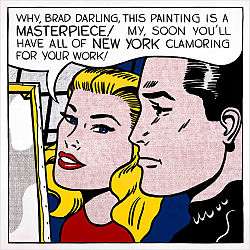Masterpiece (Roy Lichtenstein)
 | |
| Artist | Roy Lichtenstein |
|---|---|
| Year | 1962 |
| Movement | Pop art |
| Dimensions | 137 cm × 137 cm (54 in × 54 in) |
Masterpiece is a 1962 pop art painting by Roy Lichtenstein that uses his classic Ben-Day dots and a speech balloon. It is known for its narrative content that predicted Lichtenstein's fame.
Background
According to the Lichtenstein Foundation website, Masterpiece was part of Lichtenstein's first exhibition at Ferus Gallery in Los Angeles from April 1 – April 27, 1963, featuring Drowning Girl, Portrait of Madame Cézanne and other works from 1962 and 1963[1] When discussing another work (I Know...Brad), Lichtenstein stated that the name Brad sounded heroic to him and was used with the aim of cliched oversimplification.[2] Drowning Girl is another notable work with Brad as the heroic subject.[3]
The source of this image was a comic book panel with the two subjects positioned similarly to their position here, but they were situated in an automobile. In the source image the narrative content of the speech balloon said "But someday the bitterness will pass..."[4]
Masterpiece was part of the largest ever retrospective of Lichtenstein that visited The Art Institute of Chicago from May 16 to September 3, 2012, the National Gallery of Art in Washington, D.C. from October 14, 2012 to January 13, 2013, the Tate Modern in London from February 21 to May 27, 2013 and The Centre Pompidou from July 3 to November 4, 2013.[5][6][7] Several publications presented Masterpiece as part of their announcement of the retrospective.[8][9][10]
Critical response
Masterpiece is regarded as a tongue in cheek joke that reflects upon Lichtenstein's own career.[5] In retrospect, the joke is considered "witty and yet eerily prescient" because it portended some of the future turmoil that the artist would endure.[8] In the painting, the blonde female's speech bubble, "Why, Brad darling, This painting is a masterpiece! My, soon you'll have all of New York clamoring for your work!" conveys her remark as she gazes at the painting, of which a corner of the back is shown. Silent Brad conveys his agreement by his facial expression.[10] Adrian Searle of The Guardian says that the 1962 work, whose narrative and graphical content were both borrowed, was timely because Lichtenstein had his first exhibition in New York City at Leo Castelli Gallery that year, making the painting aspirational in an ironic way that comments on success and "the socio-sexual status of the hot young artist".[10] The satirical commentary on Lichtenstein's career, followed the inside joke made the year before in Mr. Bellamy.[11] According to Roberta Smith of The New York Times, Masterpiece was one of Lichtenstein's works created in a way that produced "faint and uneven" Ben Day dots.[12]
See also
Notes
- ↑ "Chronology". Roy Lichtenstein Foundation. Retrieved June 9, 2013.
- ↑ Coplans, p. 110.
- ↑ "Drowning Girl". LichtensteinFoundation.org. Retrieved June 19, 2013.
- ↑ Katie R. (July 12, 2012). "Lichtenstein FAQs, Part Two". Art Institute of Chicago. Retrieved June 19, 2013.
- 1 2 Gayford, Martin (February 20, 2013). "Roy Lichtenstein's Tate Retrospective". Bloomberg L.P. Retrieved June 19, 2013.
- ↑ Kirkova, Deni (February 19, 2013). "Pop goes the Tate! Iconic works of Roy Lichtenstein brought together for exciting new exhibition at the Tate Modern". Daily Mail. Retrieved June 7, 2013.
- ↑ "'Roy Lichtenstein: A Retrospective' Debuts At The Art Institute of Chicago (PHOTOS)". The Huffington Post. May 22, 2012. Retrieved June 8, 2013.
- 1 2 "Lichtenstein: A Retrospective". Time Out. February 26, 2013. Retrieved June 19, 2013.
- ↑ Stinebring, Anna-Claire (July 26, 2012). "Masters of surface: Roy Lichtenstein in Chicago, "Mad Men" on TV". Salon. Retrieved June 19, 2013.
- 1 2 3 Searle, Adrian (February 18, 2013). "Roy Lichtenstein: too cool for school?". The Guardian. Retrieved June 19, 2013.
- ↑ Shanes, Eric (2009). Pop Art. Parkstone Press. pp. 38 & 87. ISBN 1844846199. Retrieved June 23, 2013.
- ↑ Smith, Roberta (June 11, 2008). "The Painter Who Adored Women". The New York Times. Retrieved June 19, 2013.
References
- Coplans, John, ed. (1972). Roy Lichtenstein. Praeger Publishers.